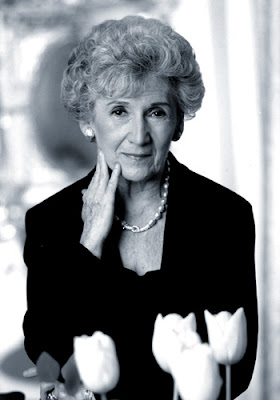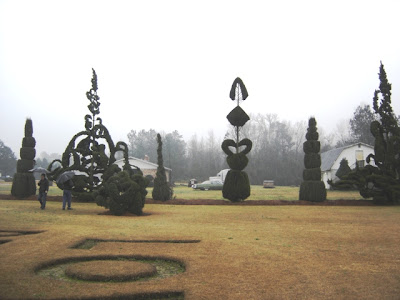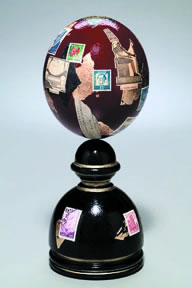 "Gawking on the Road to Compassion"
"Gawking on the Road to Compassion"
Mixed Media (Collage including Columbian volcano postage stamp
with surreal airplane cancellation and a steel engraving of a nautilus - circa 1890.)
5" x 5", 2006, Collection of Julie Osborne and Tim O'Hagan
This is a continuation of the previous entry brutally titled "HOARDING".
We've made amazing progress cleaning out the house. A crew of three of us have emptied two bedrooms, the study, two bathrooms and more and we've filled three 30 foot dumpsters containing over 250 black contractor bags stuffed with waterlogged clothes and the ephemera of a hoarder's treasure. The bones of the house have slowly reappeared. Walls appear where they should be and they terminate in perpendicular corners at the floors and ceilings. There is a slight echo. Mrs. R's museum is empty except for the cases.
----
We've also filled dozens of 15 gallon plastic bins with treasures that could be considered salvage. The bins contain the objective booty of the treasure - the wheat from the chaf - which is comprised of porcelain figures from occupied Japan, milk glass and McCoy vases, at least four heavy cast punch bowls from those decades when punch was mandatory, etc. As we've worked we've tried to pull things of value from the sludge.
----
The other two helpers are named Anthony and Daniel. They are amazing guys - sweet, compassionate and hardworking. They saw something of a
mitzvah in the work. They talk about Mrs. R. and her compulsion with respect and empathy. Admittedly, some gallow's humor circulates among us but nothing that isn't due to this crew who've taken responsibility for an evacuation. Undertakers deserve that ghoulish laugh now and then.
----
Yesterday, the wind and snow were blowing like Antartica. As we worked upstairs, the front door was blown open twice before we secured it with a 20 pound sack of salt. There have been ghostly thumps during this process - probably shadows of residual fears that provide sensations on the periphery. The incidents are announced with the same hushed phrase; "Did you hear that?" Ghosts make us pause in our work. Ghosts make us stop and wonder.
----
Around 1:30 pm, Daniel tugged at his mask and safety goggles, "Did you hear someone downstairs?" Shuffling noises were confirmed and we descended to the front hall where a stranger stood surprisingly well inside. His embroidered jacket and cap both said "Water Department". He was a workman from the village.
----
The water was shut off two months earlier when broken pipes froze and a glacier formed on the exterior of the house. When she was alive, Mrs. R. had a lengthy, running battle with the local civic bureacracy. Communitites need clear, practical policy to deal with hoarders and their families. As with any government intervention, there's a right way and a wrong way. Just cooked that blurb up. Feel free to quote.
----
With proprietary authority I asked, "Can I help you?" I landed in front of him - between the rooms and his 6 foot frame.
----
"I just saw your car and I'm with the Village and I wanted to see inside. So she died - right?" As he crained his neck he also entered my reasonable comfort zone. Around the male of our species this can mean many things. This time the transgression was a test for permission. Could he push his way through?
----
"No." I replied, "I'm sorry. We're working. And the lady who lived here was a friend." A little tension was building when he added, "I just wanted to check it out." He felt no need for politeness or compassion and he was tipping against civility. There was no concern for me as a friend of this poor dead lady. For him there was only the desire to enter a long anticipated freak show.
----
Casually and with no invention he let it blurt he said, "I just like to see how people could live like this." The phrase dangled mid-air like a huge yellow wasp. I couldn't summon indignation because that cold observation was part of my consciousness. In some ways I've been a gawker. I heard myself repeating these banal phrases as I worked him back out the door - back into the blizzard in the world and in his tiny mind; "It's a family matter and we're dealing with it. It's a sad situation. We're taking care of it."
----
I felt the shame and protectiveness that children of hoarders must feel all the time. After he left in his Village truck my temperature started to go up. I was furious and my anger was confirmed by Daniel. "That was bullshit, man."
----
We've all been gawkers on the road to compassion. Charity is filled with voyeurs. When we see tragedy, the mouth drops open a little and the neck muscles become elastic, fluid, spiral. The eyes awaken as camera lenses. The body braces like a tripod. I wonder if Buddha - during the earliest part of his journey to infinite compassion - didn't rubberneck a little.
 "Lot's Wife", 2005, enamel, salt and pastel on masonite
"Lot's Wife", 2005, enamel, salt and pastel on masonite















